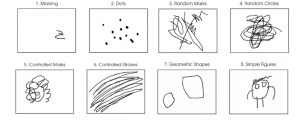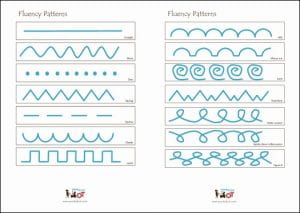Handwriting is an important fine motor skill that every child needs to develop. It is not just about putting pen to paper – it is more complex. Stephen Hawking Outreach Service has useful information on developing fine motor and early mark making skills. Here are some examples of mark making and early drawing.

http://www.stephenhawking.towerhamlets.sch.uk/attachments/download.asp?file=417&type=pdf
Model how to hold the pen / pencil
Show your child the correct way of holding the pen using thumb, index and middle fingers.

It helps to relax the grasp. A shaped pencil or a pencil grip might help.
Advice about these can be found here:
https://www.stabilo.com/uk/products/learn-to-write/graphite-pencils/stabilo-easygraph/
Ensure your child is sitting with the correct posture and with the paper at the correct angle. This will be different depending on whether they are right handed or left handed.
Handwriting Patterns
Patterns can be fun and can be made with a range of tools, such as felt tip pens and paint brushes, not just a pencil.

A book of patterns is available free from the National Handwriting Association .
Letter formation
It might be necessary to start from the beginning and go back to basics:
Letters → letter combinations → words.
Activities to help young children with letter formation can be found here.

Using lined pages helps with writing the correct size of the letters. Proportion is important.
Show your child the correct formation of a letter, where to start writing and where to place the letters on the lines for both capital and lower case letters.
Work on similar letters together e.g. c, o, a, d, g and q start in the same place.
Move on to basic joins of two or three letter combinations before whole words for example oo (as in look) oa (as in boat), ing (as in ring).
It would be helpful to check the Handwriting Policy with your child’s school.
Some schools prefer children to start cursive writing from the beginning.
Your child might find cursive writing easier, starting all letters from the base line with an ‘entry stroke.’

Practice Makes Perfect
Your child might need a lot of practice – so will need patience and encouragement from you.
For older children who are struggling, changing handwriting takes a lot of time and effort.
A ‘little and often’ approach is best with frequent breaks.
Twinkl has practice sheets to download and print.
Further guidance about handwriting can be found at the National Handwriting Association.
Harness the power of ICT
Don’t always expect your child to handwrite their work especially if they are struggling or their writing is difficult to read. For longer pieces of writing, where there is so much to think about they could dictate their ideas to a phone, tablet or laptop.
